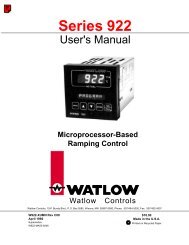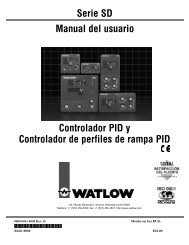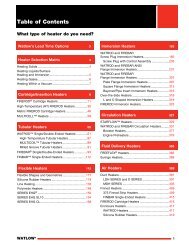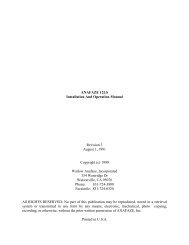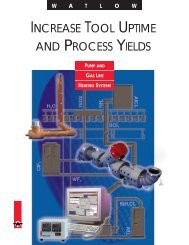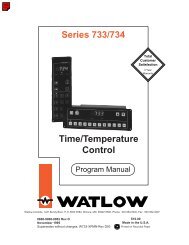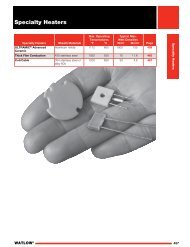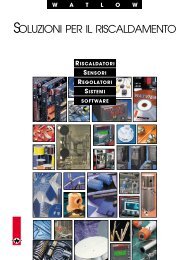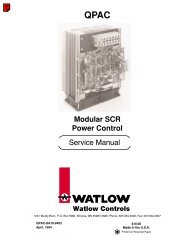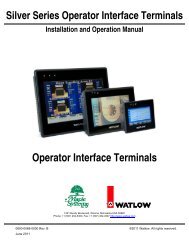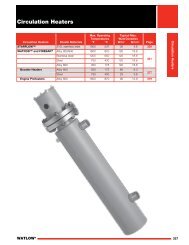EM Gateway User's Manual 0600-0040-0001 Rev D - Watlow.com.sg
EM Gateway User's Manual 0600-0040-0001 Rev D - Watlow.com.sg
EM Gateway User's Manual 0600-0040-0001 Rev D - Watlow.com.sg
Create successful ePaper yourself
Turn your PDF publications into a flip-book with our unique Google optimized e-Paper software.
<strong>EM</strong> <strong>Gateway</strong><br />
User’s <strong>Manual</strong><br />
For <strong>Watlow</strong> part number <strong>EM</strong>00-GATE-0000<br />
1241 Bundy Boulevard, P.O. Box 5580, Winona, Minnesota USA 55987-5580<br />
Phone: +1 (507) 454-5300, Fax: +1 (507) 452-4507, Internet: http://www.watlow.<strong>com</strong><br />
<strong>0600</strong>-<strong>0040</strong>-<strong>0001</strong> <strong>Rev</strong> D $10.00<br />
February 2004
<strong>EM</strong> <strong>Gateway</strong><br />
Table of Contents<br />
Chapter 1: Product Overview 4<br />
Ethernet <strong>Gateway</strong> 4<br />
Ethernet <strong>Gateway</strong> Architecture 4<br />
Program Upgrades 5<br />
Chapter 2: Installation and Wiring 6<br />
Dimensions 7<br />
Chapter 3: Configuration 8<br />
Getting Started 8<br />
Network Services 8<br />
Email Alarm Notification 8<br />
Data Logging 9<br />
Control Monitoring and Configuration 9<br />
Chapter 4: HTML Pages 10<br />
<strong>EM</strong> <strong>Gateway</strong> 10<br />
<strong>EM</strong> <strong>Gateway</strong> Setup 11<br />
<strong>EM</strong> <strong>Gateway</strong> Network Setup 12<br />
<strong>EM</strong> <strong>Gateway</strong> Email Setup 13<br />
<strong>EM</strong> <strong>Gateway</strong> Clock Setup 14<br />
<strong>EM</strong> <strong>Gateway</strong> Serial Statistics 15<br />
<strong>EM</strong> <strong>Gateway</strong> Network Statistics 16<br />
Chapter 5: Controller Parameters and Registers 17<br />
Series 96 – non-ramping 17<br />
Series 97 17<br />
Series 981 / 982 17<br />
Series 988 / 989 18<br />
Series 998 / 999 18<br />
Series F4S / F4D 18<br />
Series F4P 19<br />
MicroDin 19<br />
Power Series 19<br />
CLS200 Series 20<br />
Series SD – non-ramping 20<br />
2
<strong>EM</strong> <strong>Gateway</strong><br />
Table of Contents – cont.<br />
Chapter 6: Reference Documents 25<br />
Reference Documents 25<br />
Serial Numbers 25<br />
Chapter 7: Specifications 26<br />
Power Supply 26<br />
Environmental 26<br />
Indication 26<br />
Agency 26<br />
Communications 26<br />
Control Output Signals 26<br />
Enclosure Size 26<br />
User Interface 26<br />
Ordering Information 26<br />
Declaration of Conformity 27<br />
How to Reach Us 28<br />
3
Chapter One<br />
Product Overview<br />
The <strong>EM</strong>00-GATE-0000 is a gateway / bridge that allows up to 32 <strong>Watlow</strong> controllers to be directly<br />
connected to an Ethernet network. Using an HTTP Browser such as Microsoft Internet Explorer or<br />
Netscape Navigator you may access 16 controllers and view several controllers’ parameters via an<br />
onboard Web (HTTP) server.<br />
Ethernet <strong>Gateway</strong><br />
The Ethernet gateway provides a means for monitoring and configuring runtime parameters of multiple<br />
controllers via a web browser. The gateway is also a bridge for Modbus messages between the Ethernet<br />
bus and EIA-485 or EIA-232 links. The <strong>Gateway</strong> supports full product configuration; monitoring and<br />
configuration of runtime parameters via MODBUS TCP over TCP/IP using a software package such as<br />
Watview sold by <strong>Watlow</strong>.<br />
Ethernet <strong>Gateway</strong> Architecture<br />
This product has three physical connectivity points to the physical world. They are the serial (EIA-485 or<br />
EIA-232), Ethernet port (10BaseT), and the power supply pins.<br />
The EIA-485 / EIA-232 connection supports Modbus RTU protocol and operates as a Master port. It will<br />
initiate data read/write requests to supported standard <strong>Watlow</strong> controllers. There exists a virtual image of<br />
the controller’s data points in the gateway. The polling engine that initiates the Modbus RTU requests is<br />
responsible for synchronization of the virtual image and the actual controller. Changes to control data<br />
occur both at the controller and at the virtual image.<br />
The 10BaseT connection supports the TCP/IP stack. At the application layer it has an HTTP (web) and<br />
Modbus server. The HTTP server will provide current controller status from the virtual image via HTML.<br />
The HTTP server provides a means of changing some runtime parameters via HTML. The TCP/IP stack<br />
supports DHCP client, AutoIP, static IP, DNS client, and Netbios name resolution. The 10BaseT<br />
connector is an RJ45 per the IEEE 802.3 specification.<br />
The <strong>EM</strong>00-GATE-0000 can be used as a bridge for Modbus RTU messages. This is concurrent with all<br />
other <strong>com</strong>municating functions. In this scenario, the gateway simply passes the request that <strong>com</strong>es in on<br />
the Ethernet connection through to the EIA-485 or EIA-232 connection. When the response is returned<br />
from the controller, it is sent back on the Ethernet connection. No processing of the packet contents is<br />
necessary to bridge the two physical layers.<br />
Block Diagram of <strong>Gateway</strong><br />
PowerSource<br />
EtherNet<br />
TCP/IP<br />
Modbus<br />
TCP/IP<br />
TFTP<br />
Client<br />
GATEWAY<br />
Modbus<br />
RTU<br />
RS-485<br />
WEB<br />
Server<br />
Virtual<br />
Image<br />
Poll<br />
Engine<br />
4
Program Upgrades<br />
The gateway has a TFTP server for the purposes of reprogramming the program memory. A program<br />
update will be initiated when a TFTP client, residing on a PC, begins to write a new program file to the<br />
gateway TFTP server. When reprogramming the program memory, all other gateway services are<br />
unavailable.<br />
The gateway provides no means of updating the program memory of controller devices, such as flashing<br />
new information into the Series F4.<br />
5
Chapter Two<br />
Installation & Wiring<br />
UL Approved, Class 2 power supply<br />
required<br />
6
7<br />
Dimensions are in inches
Chapter Three<br />
Configuration<br />
Getting Started<br />
Perform these steps;<br />
1. Connect the <strong>EM</strong>00-GATE-0000 gateway to your <strong>com</strong>puter’s Ethernet port using a cross-wired RJ45<br />
cable or connect the <strong>EM</strong>00-GATE-0000 to a hub or network using a straight wired RJ45 Category 5<br />
cable. The <strong>EM</strong>00-GATE-0000 is limited to a 10BaseT connection and will not work on an Ethernet<br />
port set for 100BaseT only. Use of a 10/100 hub will over<strong>com</strong>e this issue if your PC has only a<br />
100BaseT port.<br />
2. Wire the temperature controllers to the gateway’s EIA-485 port. You may connect the gateway’s EIA-<br />
232 port to a controller if you will be using only one controller, provided that the controller has an EIA-<br />
232 port.<br />
3. Wire a 24-volt AC or DC power supply to the gateway terminals. This is not polarity sensitive.<br />
4. Configure each controller to the same baud rate (9600 or 19200) from the front panel of the<br />
controller. Set each controller’s Modbus address to a unique number. As an example, set the first<br />
controller to address 1, the second to address 2 and so on.<br />
5. Power up the gateway, controllers and PC.<br />
6. Start your Internet browser. Enter the TCP/IP address of the gateway into the browsers’ address field.<br />
Two different addresses may be used to access the gateway. Either <strong>EM</strong>xxxxxx, where xxxxxx is the<br />
first six digits of the serial number, or WATxxxxxx, where xxxxxx is the last six digits of the gateways’<br />
MAC address. The MAC address is printed on a decal in the form xx:xx:xx:xx:xx:xx.<br />
7. Select the <strong>Gateway</strong> Setup Page. Enter User name ‘new’ and Password ‘user’ by default. The<br />
Password can be changed on the Security Configuration screen.<br />
8. Configure the Baud Rate and range of controllers’ addresses to match those you configured in step<br />
four.<br />
9. Click on Rescan Modbus Network<br />
10. Click on the back button of the browser to return to the previous page.<br />
11. Click on the refresh button of the browser and your controllers’ information should now be visible.<br />
Note: You must click on the refresh button within the browser to capture the latest controller information.<br />
This information is automatically refreshed after 10 seconds by default. You may change this refresh time<br />
using the appropriate page.<br />
Network Services<br />
The <strong>EM</strong>00-GATE-0000 supports DHCP client, autoIP, and static IP for address assignment. Normally you<br />
will not need to make any changes. The user is able to configure preferences as to which services are<br />
used if available. Intelligence is employed within the gateway to revert to backup IP assignment methods<br />
if the primary method is unavailable.<br />
The gateway does support DNS client and Netbios name resolution. Configuration information may be<br />
entered at the <strong>EM</strong> <strong>Gateway</strong> Network Display Setup page.<br />
Email Alarm Notification<br />
The email function allows the user to send emails to four addresses alerting them of alarm conditions that<br />
have occurred on the controllers connected to the <strong>Gateway</strong>. A button on the Graphical User Interface<br />
(GUI) allows the user to enable or disable this feature. Emails can be generated whenever an alarm<br />
condition occurs for each controller. An email acknowledge feature requires that the user acknowledge<br />
the email message by operating the email acknowledge button before additional email alarm messages<br />
can be generated for that controller. For multiloop controllers only one email acknowledge feature is<br />
supported; if more than one loop produces an alarm, only the first alarm detected will generate an email<br />
until acknowledged.<br />
8
You will need to configure your <strong>Gateway</strong> with your SMTP server name or address. A DNS server address<br />
must also be configured if using a SMTP name. Contact your system administrator if you don’t know the<br />
SMTP name or address.<br />
Data Logging<br />
The gateway provides no explicit means of data logging. Data can be polled via Modbus TCP by an<br />
external PC program. Consider WatView from <strong>Watlow</strong> for your setup, data logging and graphing needs.<br />
Control Monitoring and Configuration<br />
The gateway provides a means of monitoring the current process value for analog inputs of each<br />
controller using a built-in HTTP server. It also provides a means of monitoring the present alarm status of<br />
each controller. Additionally, you may monitor and change control set points for control loops of each<br />
controller.<br />
The gateway is capable of supporting <strong>Watlow</strong> Series 96 non-ramping, 97, 981, 982, 988, 989, 998, 999,<br />
F4S, F4D, F4P, MicroDin, Power Series, CLS200and SD non-ramping controllers with up to 16<br />
controllers in any <strong>com</strong>bination.<br />
The gateway is capable of automatically determining when a controller is connected to the serial bus. It<br />
will identify the model and address of each controller. Controllers with duplicate Modbus addresses will<br />
be ignored by the gateway.<br />
You can configure the baud rate of the EIA-485 or EIA-232 bus. You may also specify which controller<br />
addresses are scanned under the <strong>EM</strong> <strong>Gateway</strong> Setup page. The gateway supports from 1 to 16<br />
controllers in any <strong>com</strong>bination of supported model numbers. Select Rescan Modbus Network to update<br />
the detection of controllers on the bus. The Modbus network is automatically scanned every two minutes<br />
for new devices.<br />
9
Chapter Four<br />
HTML Pages<br />
The section describes the pages available from the <strong>EM</strong> <strong>Gateway</strong>’s Web server.<br />
When the web page is first accessed, you are prompted for a User name and Password. The default User<br />
name is ‘new’. The default Password is ‘user’. These are case sensitive. The user name and password<br />
may be changed on the security configuration page.<br />
F4 1 Auto 1) Ok 100 120 Alarm 1 Ok<br />
2) Ok 135 136<br />
Series 982 2 Hold 1) Ok 78 78 Alarm 2 Ok<br />
2) Ok Alarm 3 Ok<br />
This is the main page for monitoring the controllers on the <strong>Gateway</strong>. You can click on values that are located<br />
within a box. Entering in a new value may change these values. In addition, use Alarm Ack to clear alarms when a<br />
process value has returned within a safe operating range. Use the Email Ack to reactivate future emails for this<br />
controller. See the controller’s user’s manuals for details of Modes, Errors, and Alarm operation.<br />
10
Use this page to disable or enable automatic page refreshing or to change the time in between<br />
refreshes.<br />
In addition, you can force a rescan of the Modbus Network. This will cause the <strong>Gateway</strong> to detect any<br />
new devices added to the serial network. Set the baud rate of the network to 9600 or 19200-baud. The<br />
value selected must match the value in all of the controllers on the serial network. Up to 16 controllers<br />
may be scanned by the <strong>Gateway</strong> using the built-in HTTP server. Set a start address to the lowest<br />
address number of the controller on the serial network. Set an end address to the highest address<br />
number of the controller on the serial network.<br />
As an example, you have your first controller set to address 23 and the last one set to 35. Set Start<br />
Address to 23 and End Address to 35. You can limit the number of controllers accessed by the<br />
<strong>Gateway</strong> by setting the Maximum Nodes value to less than 16.<br />
Lastly, this page provides links to Network Setup, Email Setup, Clock Setup, Network Statistics, and<br />
the Serial Statistics pages.<br />
11
Use this page to change the <strong>Gateway</strong> identification name or to change the IP Address Resolution<br />
Method. Contact your IS administrator for questions regarding these settings.<br />
12
Use this page to enable notification and configure the addresses for email recipients. These recipients<br />
will receive an email when an alarm occurs on any controller. Contact your IS administrator for<br />
questions regarding these settings.<br />
13
Use this page to update the time and date stored in the <strong>Gateway</strong>. This information is used to identify<br />
the time and date of alarms when emails are sent.<br />
14
1 0 0 0 0 1174 0<br />
2 0 0 0 0 1174 0<br />
3 0 0 0 0 1174 0<br />
4 0 0 0 0 1174 0<br />
5 0 0 0 0 1174 0<br />
6 0 0 0 0 1174 0<br />
7 0 0 0 0 1174 0<br />
8 0 0 0 0 1174 0<br />
9 0 0 0 0 1174 0<br />
10 0 0 0 0 1174 0<br />
11 5 2 0 3 1167 0<br />
12 0 0 0 0 1174 0<br />
13 0 0 0 0 1174 0<br />
14 0 0 0 0 1174 0<br />
15 0 0 0 0 1174 0<br />
16 0 0 0 0 1174 0<br />
The Serial Statistic page is used to monitor the health of the controller network. These numbers will<br />
help identify when there are issues with wiring, duplicate Modbus ID addresses or noise on<br />
<strong>com</strong>munication wires on the controller side of the network. In this example, controller number 11 is<br />
experiencing failure in <strong>com</strong>munication quality.<br />
Timeout Errors increments anytime that a controller does not respond in an appropriate amount of<br />
time.<br />
Retry Errors increments anytime that a controller does not respond after 3 attempts to read<br />
information.<br />
CRC Errors increments anytime that the controller responds with a bad packet.<br />
Bad Polls increments when there are timeouts and the retries did not successfully retrieve information.<br />
Good Polls increments on each valid packet received.<br />
Illness increments anytime that there are 5 CRC or Timeout errors in a row. After a count of 5 in the<br />
Illness column, the controller is flagged as having no <strong>com</strong>munication. On the next valid packet<br />
received, the Illness value is cleared to zero and <strong>com</strong>munications is restored.<br />
You must refresh the browser to see these numbers update.<br />
15
This page was loaded Wed Feb 1318: 00:28 2002<br />
IP Address 7.3.37.91<br />
Subnet 255.255.224.0<br />
<strong>Gateway</strong> 7.3.63.250<br />
Mac Address<br />
00:03:AA:00:00:C1<br />
Receives 128349<br />
Unicasts 1207<br />
Multicasts 0<br />
Broadcasts 127061<br />
Rx Errors 0<br />
Rx Missed 2089<br />
Rx CRC Errors 28<br />
Rx Drops 0<br />
Transmits 1251<br />
Buffer Defers 0<br />
Tx Errors 0<br />
Tx Collisions 0<br />
Tx Coll. Overflow 0<br />
Tx FILO Errors 0<br />
Traffic Backoffs 0<br />
Network Rejects 84154<br />
Address Rejects 25<br />
Protocol Rejects 10492<br />
ARP Rejects 19361<br />
SMTP Server IP 0.0.0.0<br />
Send Queue Length 0<br />
Send Queue Max 1<br />
Send Queue Min 0<br />
Recv Queue Length 0<br />
Recv Queue Max 7<br />
Recv Queue Min 0<br />
Big Queue Length 28<br />
Big Queue Max 30<br />
Big Queue Min 26<br />
Little Queue Length 28<br />
Little Queue Max 30<br />
Little Queue Min 2<br />
The Network Statistics page monitors the health of the Ethernet network. These numbers will help identify<br />
settings for the <strong>EM</strong> <strong>Gateway</strong> as well as when there are issues with wiring, incorrect addresses or noise<br />
on <strong>com</strong>munication wires on the Ethernet side of the <strong>Gateway</strong>.<br />
16
Chapter Five<br />
Controller Parameters and Registers<br />
The <strong>EM</strong> <strong>Gateway</strong> supports the following parameters for each type of controller when using an HTTP<br />
browser:<br />
Series 96 – non-ramping<br />
Operation Mode – register 200 with choice of Auto or <strong>Manual</strong> as read only<br />
Input Error – register 101 with choice of Sensor Error or Ok as read only<br />
Process Value Input 1 – register 100 as read only<br />
Process Value Input 2 – register 105 as read only<br />
Auto Set Point 1 – register 300 as read/write<br />
Alarm Status Output 2 – register 106 with choice of Ok, Alarm High, Alarm Low, Alarm High Latched,<br />
Alarm Low Latched, Alarm High Silenced, Alarm Low Silenced, Alarm High Latched Silenced, Alarm<br />
Low Latched Silenced, Waiting for in Range Alarm, Alarm Disabled, or Alarm Error as read only<br />
Alarm Status Output 3 – register 106 with choice of Ok, Alarm High, Alarm Low, Alarm High Latched,<br />
Alarm Low Latched, Alarm High Silenced, Alarm Low Silenced, Alarm High Latched Silenced, Alarm<br />
Low Latched Silenced, Waiting for in Range Alarm, Alarm Disabled, or Alarm Error as read only<br />
Alarm Acknowledge – register 331 with choice to clear alarm as write only<br />
Note: Selecting <strong>Manual</strong> control using the Operation Mode, an input error or inputting a Set Point value<br />
less than –30000 will disable the Auto Set Point. Alarms not configured are not displayed. Alarms can not<br />
be acknowledged while the alarm condition exists.<br />
Series 97<br />
Process Value Input 1 – register 100 as read only<br />
Limit Status – register 319 with choice of Ok, High Limit, Low Limit, or Limit Error as read only<br />
Alarm Status Output 2 – register 106 with choice of Ok, Alarm High, Alarm Low or Alarm Error as read<br />
only<br />
Alarm Status Output 3 – register 110 with choice of Ok, Alarm High, Alarm Low, or Alarm Error as read<br />
only<br />
Alarm Acknowledge – register 331 with choice to clear alarm as write only<br />
Note: Alarms configured are displayed. Alarms can not be acknowledged while the alarm condition exists.<br />
Series 981 / 982<br />
Operation Mode – register 200 with choice of Hold, Run, or Pre-run as read only<br />
Input Error – register 209 with choice of Sensor Error or Ok as read only<br />
Process Value Input 1 – register 100 as read only<br />
Auto Set Point – register 300 as read/write<br />
Alarm Status Output 2 – register 106 with choice of Ok, Alarm High, Alarm Low or Alarm Error as read<br />
only<br />
Alarm Status Output 3 – register 110 with choice of Ok, Alarm High, Alarm Low, or Alarm Error as read<br />
only<br />
Alarm Acknowledge – register 106 with choice to clear alarm as write only<br />
Note: An input error or inputting Set Point values less than –30000 will disable the Auto Set Point. Alarms<br />
not configured are not displayed. Alarms can not be acknowledged while the alarm condition exists.<br />
17
Series 988 / 989<br />
Operation Mode – register 10 with choice of Auto or <strong>Manual</strong> as read only<br />
Input Error – register 4 with choice of Sensor Error or Ok as read only<br />
Process Value Input 1 – register 1 as read only<br />
Process Value Input 2 – register 2 as read only<br />
Auto Set Point – register 7 as read/write<br />
Alarm Status Output 2/3 – register 3 with choice of Ok, Alarm High, Alarm Low or Alarm Error as read<br />
only<br />
Alarm Acknowledge – register 3 with choice to clear alarm as write only<br />
Note: Selecting <strong>Manual</strong> control using the Operation Mode, an input error or inputting Set Point values less<br />
than –30000 will disable the Auto Set Point. Alarms not configured are not displayed. Alarms can not be<br />
acknowledged while the alarm condition exists.<br />
Series 998 / 999<br />
Operation Mode – register 301 with choice of Auto or <strong>Manual</strong> as read only<br />
Input Error – register 209 with choice of Sensor Error or Ok as read only<br />
Process Value Input 1 – register 100 as read only<br />
Process Value Input 2 – register 104 as read only<br />
Auto Set Point 1 – register 300 as read/write<br />
Auto Set Point 2 – register 319 as read/write<br />
Alarm Status Output 3 – register 110 with choice of Ok, Alarm High, Alarm Low, or Alarm Error as read<br />
only<br />
Alarm Acknowledge – register 110 with choice to clear alarm as write only<br />
Note: Selecting <strong>Manual</strong> control using the Operation Mode, an input error or inputting Set Point values less<br />
than –30000 will disable Auto Set Points 1 or 2. Alarms not configured are not displayed. Alarms can not<br />
be acknowledged while the alarm condition exists.<br />
Series F4S / F4D<br />
Operation Mode – register 200 with choice of Auto or <strong>Manual</strong> as read only<br />
Input 1 Error – register 101 with choice of Sensor Error or Ok as read only<br />
Input 2 Error – register 105 with choice of Sensor Error or Ok as read only<br />
Input 3 Error – register 109 with choice of Sensor Error or Ok as read only<br />
Process Value Input 1 – register 100 as read only<br />
Process Value Input 2 – register 104 as read only<br />
Process Value Input 3 – register 108 as read only<br />
Auto Set Point 1 – register 300 as read/write<br />
Auto Set Point 2 – register 319 as read/write<br />
Alarm Status Output 2 – register 102 with choice of Ok, Alarm High, Alarm Low, Alarm High Latched,<br />
Alarm Low Latched, Alarm High Silenced, Alarm Low Silenced, Alarm High Latched Silenced, Alarm<br />
Low Latched Silenced, Waiting for in Range Alarm, Alarm Disabled, or Alarm Error as read only<br />
Alarm Status Output 3 – register 106 with choice of Ok, Alarm High, Alarm Low, Alarm High Latched,<br />
Alarm Low Latched, Alarm High Silenced, Alarm Low Silenced, Alarm High Latched Silenced, Alarm<br />
Low Latched Silenced, Waiting for in Range Alarm, Alarm Disabled, or Alarm Error as read only<br />
Alarm 1 Acknowledge – register 312 with choice to clear alarm as write only<br />
Alarm 2 Acknowledge – register 331 with choice to clear alarm as write only<br />
Note: Alarms configured are displayed. Alarms can not be acknowledged when the alarm condition still<br />
exists.<br />
18
Series F4P<br />
Operation Mode – register 200 with choice of Auto or <strong>Manual</strong> as read only<br />
Input 1 Error – register 101 with choice of Sensor Error or Ok as read only<br />
Input 2 Error – register 105 with choice of Sensor Error or Ok as read only<br />
Input 3 Error – register 109 with choice of Sensor Error or Ok as read only<br />
Process Value Input 1 – register 100 as read only<br />
Process Value Input 2 – register 104 as read only<br />
Process Value Input 3 – register 108 as read only<br />
Auto Set Point – register 300 as read/write<br />
Alarm Status Output 2 – register 102 with choice of Ok, Alarm High, Alarm Low, Alarm High Latched,<br />
Alarm Low Latched, Alarm High Silenced, Alarm Low Silenced, Alarm High Latched Silenced, Alarm<br />
Low Latched Silenced, Waiting for in Range Alarm, Alarm Disabled, or Alarm Error as read only<br />
Alarm Status Output 3 – register 106 with choice of Ok, Alarm High, Alarm Low, Alarm High Latched,<br />
Alarm Low Latched, Alarm High Silenced, Alarm Low Silenced, Alarm High Latched Silenced, Alarm<br />
Low Latched Silenced, Waiting for in Range Alarm, Alarm Disabled, or Alarm Error as read only<br />
Alarm 1 Acknowledge – register 312 with choice to clear alarm as write only<br />
Alarm 2 Acknowledge – register 331 with choice to clear alarm as write only<br />
Note: Alarms configured are displayed. Alarms can not be acknowledged when the alarm condition still<br />
exists.<br />
MicroDIN<br />
Operation Mode – register 200 with choice of Auto or <strong>Manual</strong> as read only<br />
Input Error – register 101 with choice of Sensor Error or Ok as read only<br />
Process Value Input 1 – register 100 as read only<br />
Auto Set Point – register 300 as read/write<br />
Alarm Status Output 2 – register 106 with choice of Ok, Alarm High, Alarm Low, Alarm High Latched,<br />
Alarm Low Latched, Alarm High Silenced, Alarm Low Silenced, Alarm High Latched Silenced, Alarm<br />
Low Latched Silenced, Waiting for in Range Alarm, Alarm Disabled, or Alarm Error as read only<br />
Alarm Acknowledge – register 331 with choice to clear alarm as write only<br />
Note: Alarms configured are displayed. Alarms can not be acknowledged when the alarm condition still<br />
exists.<br />
Power Series<br />
Heat Sink Temperature in Degrees C - register 1590 as read only<br />
Load Current in Amps RMS on Line 1 - register 154 as read only (Based on configuration)<br />
Load Current in Amps RMS on Line 2 - register 164 as read only (Based on configuration)<br />
Load Current in Amps RMS on Line 3 - register 174 as read only (Based on configuration)<br />
Note: Display of current on lines 1, 2, and 3 depends on the number of zones, the installed options and<br />
the load type.<br />
19
CLS200 Series (Loop 1 to 16 if available)<br />
Operation Mode – register 264 to 279 with choice of Auto or <strong>Manual</strong> as read only<br />
Input Error – registers 660 to 675 with choice of Ok, TC <strong>Rev</strong>ersed, TC Short, TC Open, RTD Open, or<br />
RTD Short as read only<br />
Process Value – registers 363 to 378 as read only<br />
Auto Set Point – registers 330 to 345 as read/write<br />
Alarm Status – registers 660 to 675 with choice of Ok, Low Deviation, High Deviation, Low Process, or<br />
High Process as read only<br />
Alarm Acknowledge – registers 8311 to 8326 with choice to clear alarm as write only<br />
Note: Alarms configured are displayed. Alarms can not be acknowledged when the alarm condition still<br />
exists.<br />
Note: The Communication Specifications manual list absolute registers, which are the relative register<br />
with 4<strong>0001</strong> added to them. As an example, relative register 264 is absolute register 40265.<br />
Series SD – non-ramping<br />
Operation Mode – register 25 with choice of Auto or <strong>Manual</strong> as read only<br />
Input Error – registers 24 with choice of Ok or Error as read only<br />
Process Value – registers 20, 21 as read only<br />
Auto Set Point – registers 27, 28 as read/write<br />
Alarm 1 Status – registers 29 and 30 of Alarm 1 Ok, Alarm 1 Low Alarm, or Alarm 1 High Alarm as read<br />
only<br />
Alarm 2 Status – always OK as this is the same output as <strong>com</strong>munications.<br />
Alarm 3 Status – registers 33 and 34 of Alarm 3 Ok, Alarm 3 Low Alarm, or Alarm 3 High Alarm as read<br />
only<br />
Note: Alarms configured are displayed. Alarms can not be acknowledged when the alarm condition still<br />
exists.<br />
In addition, the Series SD has many other parameters to read or change by clicking on the link<br />
SeriesSD. Be sure to submit any changes made on these screens using the Submit button at the bottom<br />
of the screen.<br />
The following are screen captures from the Series SD:<br />
20
Chapter Six<br />
Reference Documents<br />
The MODBUS RTU specification is located at: http://www.modicon.<strong>com</strong>/techpubs/toc7.html or<br />
http://www.modbus.org<br />
Serial Numbers<br />
<strong>Gateway</strong>s are labeled with a unique serial number in numeric and bar code formats. The serial number is<br />
embedded in the gateway firmware.<br />
<strong>EM</strong> <strong>Gateway</strong> Features and Benefits<br />
• Ethernet/Internet connectivity<br />
Operate & monitor your process remotely.<br />
• Browser Graphical User Interface (GUI)<br />
Operate & monitor your process remotely with standard Web browsers.<br />
• Dedicated Web page design<br />
Easy to understand and operate<br />
• Email alarm notification<br />
Reduced process monitoring costs<br />
25
Chapter Seven<br />
Specifications<br />
Power supply<br />
• Voltage input 24 V (ac/dc) +10%, -15% 50/60 Hz +/- 5<br />
• Connection through 2-position removable screw style terminal block<br />
• 22 to 12 AWG<br />
• Power consumption 10 VA MAX<br />
• UL Approved, Class 2 power supply required<br />
• Real-time Clock backed by 3v-lithium battery – RAYOVAC BR1225<br />
Environmental<br />
• Operating temperature range: 0 to 60°C<br />
• Storage temperature range: -40 to 70°C<br />
• Operating and storage humidity: 0 to 90% non-condensing<br />
Indication<br />
• Green LED for Ethernet connection<br />
• Green LED for Ethernet activity<br />
• Green LED for EIA-485 or EIA-232 activity<br />
Agency<br />
• CE Approved, see Declaration of Conformity 61326 Industrial Immunity, Class B Emissions<br />
Communications<br />
• MODBUS RTU <strong>com</strong>munications<br />
• Both EIA-485 and EIA-232 supported at 9600 and 19200 baud<br />
• Connection through 5-position removable screw style terminal block<br />
• 22 to 12 AWG<br />
• Ethernet <strong>com</strong>munications<br />
• Ethernet RJ45 Connector<br />
• 10BaseT per IEEE 802.3 Ethernet Standard<br />
• HTTP v1.1<br />
• Modbus TCP<br />
• DHCP, Auto IP, Or Fixed IP Address<br />
• Email Alarm Notification<br />
• Supports Windows browsers<br />
• Microsoft Internet Explorer 4.0 or newer<br />
• Netscape 4.0 or newer<br />
Control Output Signals<br />
Activity L.E.D. for Ethernet <strong>com</strong>munications per IEEE 802.3<br />
Activity L.E.D. for Serial <strong>com</strong>munications.<br />
Enclosure Size<br />
Dimensional Size - L: 3.75 in X W: 1 in X H: 2.5 in, with cutouts for L.E.D.s, RJ45 port and power jack.<br />
User Interface<br />
3 L.E.D.s to indicate operation status; Ethernet link, Ethernet traffic and Modbus traffic.<br />
Ordering Information<br />
Order part number <strong>EM</strong>00-GATE-0000<br />
26
Declaration of Conformity<br />
<strong>Gateway</strong> Products<br />
<strong>Watlow</strong> Winona, Inc.<br />
1241 Bundy Blvd.<br />
Winona, MN 55987 USA<br />
Declares that the following product:<br />
Model Numbers:<br />
Classification:<br />
Rated Voltage:<br />
Rated Frequency:<br />
Rated Power:<br />
<strong>EM</strong>00-GATE-0000, NGW0-0000-2400 and NGW0-0000-0000*<br />
Communications interface card, Installation Category I, Pollution<br />
degree II<br />
24V (ac or dc) or 5V (dc)<br />
50/60 Hz or dc<br />
10VA maximum<br />
*NGW0-0000-0000 Requires use of a Ferrico NF130 Clamp on ferrite on all lines to pass Class B<br />
emissions. Depending on end use setup, this bead may or may not be necessary.<br />
Meets the essential requirements of the following European Union Directives by using the relevant<br />
standards show below to indicate <strong>com</strong>pliance.<br />
89/336/EEC Electromagnetic Compatibility Directive<br />
EN 61326:1997 With A1:1998 – Electrical equipment for measurement, control and<br />
laboratory use – <strong>EM</strong>C requirements (Industrial Immunity, Class B Emissions).<br />
EN 61000-4-2:1996 With A1, 1998 – Electrostatic Discharge Immunity<br />
EN 61000-4-3:1997 – Radiated Field Immunity<br />
EN 61000-4-4:1995 – Electrical Fast-Transient / Burst Immunity<br />
EN 61000-4-5:1995 With A1, 1996 – Surge Immunity<br />
EN 61000-4-6:1996 – Conducted Immunity<br />
EN 61000-4-11:1994 Voltage Dips, Short Interruptions and Voltage Variations Immunity<br />
EN 61000-3-2:1995 With A1-3:1999 – Harmonic Current Emissions<br />
EN 61000-3-3:1995 With A1:1998 – Voltage Fluctuations and Flicker<br />
Use of an appropriately approved class 2 power source is required for <strong>com</strong>pliance.<br />
Jim Boigenzahn<br />
Name of Authorized Representative<br />
Winona, Minnesota, USA<br />
Place of Issue<br />
General Manager February 28, 2002<br />
Title of Authorized Representative<br />
Date of Issue<br />
Signature of Authorized Representative<br />
27
How to Reach Us<br />
Technical Assistance<br />
If you encounter a problem with your <strong>EM</strong> <strong>Gateway</strong>, review all of your wiring and configuration information<br />
to verify that your selections are consistent with your application. If the problem persists after checking<br />
the above, you can get technical assistance from your local <strong>Watlow</strong> representative, or by dialing (507)<br />
454-5300. An applications engineer will discuss your application with you.<br />
Warranty<br />
This product is warranted free from defects in material and workmanship for 36 months after delivery to<br />
the first purchaser for use, providing that the units have not been misapplied. Since <strong>Watlow</strong> has no<br />
control over their use, and sometimes misuse, we cannot guarantee against failure. <strong>Watlow</strong>’s obligations<br />
hereunder, at <strong>Watlow</strong>’s option, are limited to replacement, repair or refund of purchase price, and parts<br />
that upon examination prove to be defective within the warranty period specified. This warranty does not<br />
apply to damage resulting from transportation, alteration, misuse or abuse.<br />
Returns<br />
• Call or fax Customer Service for a Return Material Authorization (RMA) number before returning any<br />
product.<br />
• Put the RMA number on the shipping label, and provide a written description of the problem.<br />
• A restocking charge of 20% of the net price is charged for all standard units returned to stock.<br />
Your Feedback<br />
Your <strong>com</strong>ments or suggestions on this manual are wel<strong>com</strong>e, please send them to: Technical Writer,<br />
<strong>Watlow</strong> Winona, 1241 Bundy Blvd., P.O. Box 5580, Winona, MN 55987-5580, Phone: (507) 454-5300,<br />
Fax: (507) 452-4507. <strong>Watlow</strong> Winona, Inc., ©, copyrights the <strong>EM</strong> User’s <strong>Manual</strong> February 2002, with all<br />
rights reserved. (2206)<br />
28



